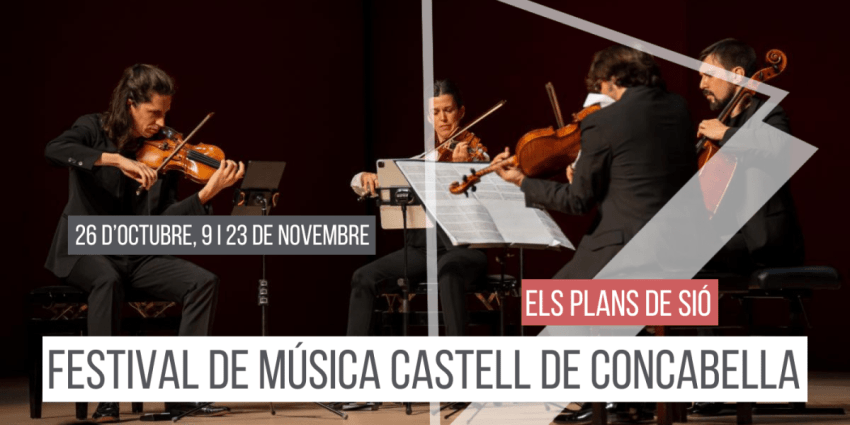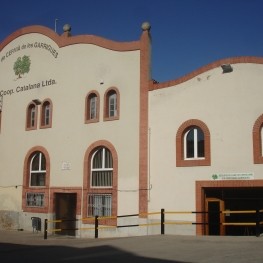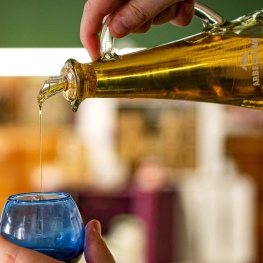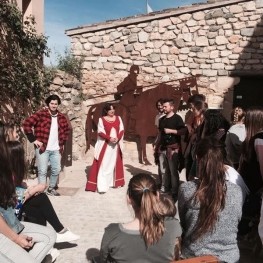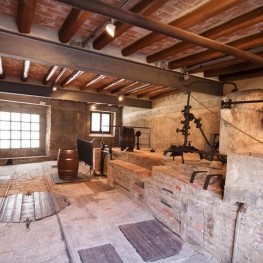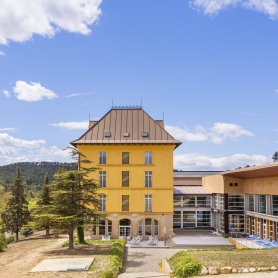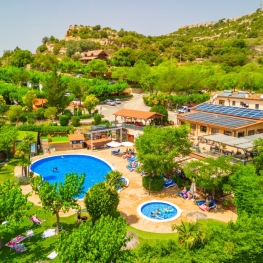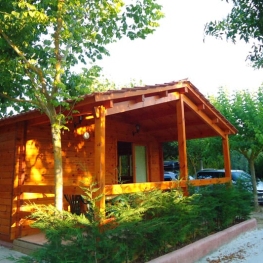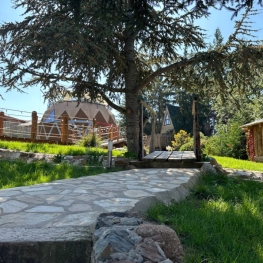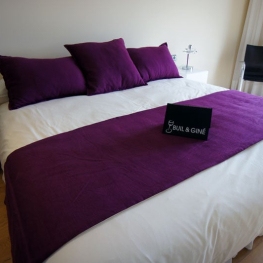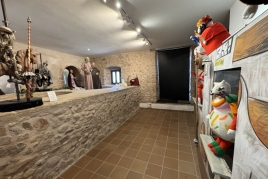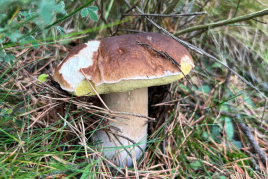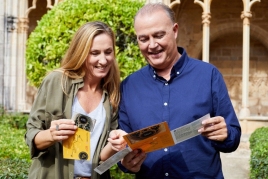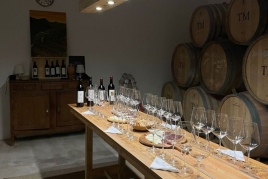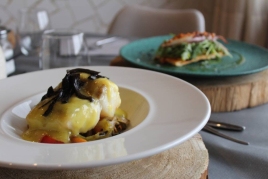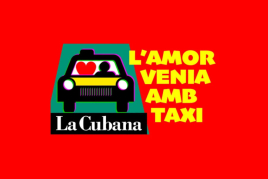Walking around l'Albi
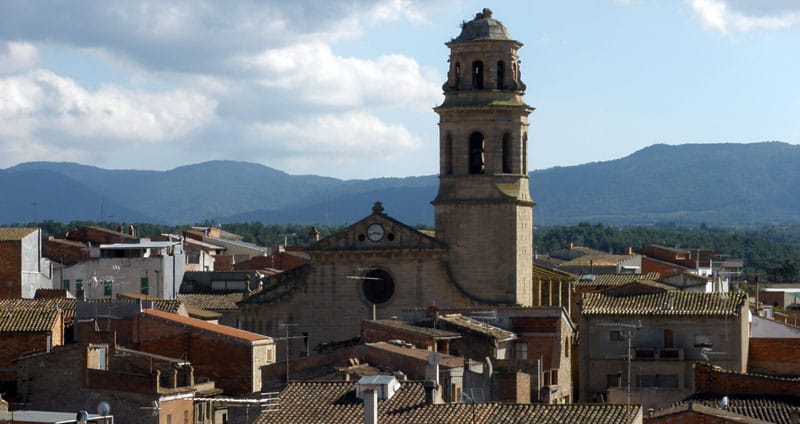
Only 17 miles from the monastery of Poblet, 15 of Les Borges Blanques and 22 Montblanc found the town of L'Albi, surrounded by olive trees and full of attractions ranging from the modernist architect Cesar Martinell cellar to the castle that from about a thousand years ago, chairs the villa. We propose a route through the streets of this town south of the county of Les Garrigues, with an intimate and undisturbed arcaded square as the center and if you have time, we recommend acercaris the Valley of Coma, less than 6 km, where waiting for millennia cave paintings declared World Heritage by UNESCO.
byHave you left this morning for a visit to the Cistercian monks of Poblet and now I still have some time until lunchtime? Have no doubt and Turn to L'Albi, a city that can be visited without having to spend many hours where soon find interesting buildings and streets meet, and where the roots and spirit garriguenses preserved, with oil and olives seems that I have to go out and greet at any time. So if ye lunchtime ago, certainly in its restaurants can taste an oil premium. How can you get? Taking the AP-2 motorway, take exit 8 and I will plant in the town in the blink of an eye. You can also enter the villa through the local road LP 7032, linking Vinaixa with the N-240 from Tarragona to Lleida. The Hispanic Igualadina stops in its line of intercity buses linking Barcelona with Torregrossa and the Vibasa company that travels between Lleida and La Pobla de Cérvoles. If you choose public transportation, however, think that the frequency is low.
Patterns
 We do very well start the itinerary at the foot of the chapel of Saints Cosmas and Damian, because he is at one end of the town practically within a field olivos-, because it is an important building for the people of L ' Albi, and that relates to what we already see up there and that crowns the place; as you can imagine, we are referring to the castle, we will visit later. We split.
We do very well start the itinerary at the foot of the chapel of Saints Cosmas and Damian, because he is at one end of the town practically within a field olivos-, because it is an important building for the people of L ' Albi, and that relates to what we already see up there and that crowns the place; as you can imagine, we are referring to the castle, we will visit later. We split.
Saints Cosmas and Damian, Saints Medical, are the patterns of L'Albi, and to honor them a feast celebrated every year on September 26th. The villagers carried in procession on the eve, the images of the two saints that are inside the chapel to the parish. There, 26 held a solemn profession and then move the Saints back to the chapel, where they remain throughout the year. The neighbors appreciate this shape patterns that the summer of 1885 or any albinenc albinenca died from cholera, which raged everywhere. The villagers ran again and again his pleas during those days: "Saints Cosmas and Damian, deliver us from the pestilence."
 The images of the Medical Saints are not the only ones we see in the interior of the chapel at the door, also are represented. There are some paintings from the castle representing the Saints Abdon and Senen, and another of San Antonio de Padua. As for the building, because it is a chapel can be considered large, and highlights the porch Sit a while on the bench in the shade, and hear the silence of the surroundings-and bell tower, with square bottom octagonal and higher. The interior of the chapel is a single nave, spacious with four side chapels. Its origins date back to the sixteenth century or late fifteenth, but its appearance today is spotless thanks to the restoration of 1909 and, above all, thanks to the restoration that took place after the civil war since the conflict war-and the first few days, on 24 July 1936 touched to receive.
The images of the Medical Saints are not the only ones we see in the interior of the chapel at the door, also are represented. There are some paintings from the castle representing the Saints Abdon and Senen, and another of San Antonio de Padua. As for the building, because it is a chapel can be considered large, and highlights the porch Sit a while on the bench in the shade, and hear the silence of the surroundings-and bell tower, with square bottom octagonal and higher. The interior of the chapel is a single nave, spacious with four side chapels. Its origins date back to the sixteenth century or late fifteenth, but its appearance today is spotless thanks to the restoration of 1909 and, above all, thanks to the restoration that took place after the civil war since the conflict war-and the first few days, on 24 July 1936 touched to receive.
 Taking the wide street that starts right in front of the chapel, which also sports the name of the holy martyrs and patterns of L'Albi, find a modern sculpture: a snail Featured measures. The book signing Josep M. Cunillera and Roure and gives us good example of the regard they have for these lands of this animal, probably more like food company as a bug...
Taking the wide street that starts right in front of the chapel, which also sports the name of the holy martyrs and patterns of L'Albi, find a modern sculpture: a snail Featured measures. The book signing Josep M. Cunillera and Roure and gives us good example of the regard they have for these lands of this animal, probably more like food company as a bug...
The men
 The drop that makes the street leads header to pla Pou, a large open area at the confluence of several roads, including the main street. We, however, take now one that is still wider, Cervià path, and we want to go see the church of Santa Maria. On the way we will leave a few washes and after climbing stairs, we are in front of the neoclassical facade of the parish. The temple stands on a previous one, the twelfth century. What we see today was inaugurated on November 11, 1751 and abroad, the highlight is the round tower, 34 meters high. Inside, unfortunately, like the chapel, civil war also made an appearance, and many of the works they inhabited, as an exquisite altar sculptor Feliu de Sayar or an old body that was already in the previous building They eventually turned into ashes. Thus, the most interesting remains today in Renaissance church of Santa Maria is the crypt under the chancel, which were buried in 1751 the barons of Albi. The men were those who inhabited the castle and had a great importance in the territory along different stages and historical moments. They say that the 28th man, Pere Alcàntara Rocabruna, burned the castle during the Carlist Wars, preferring to see it burned in the hands of the Liberals. Since then-that was the nineteenth century the castle was abandoned. End up talking when we come to it. For now, we are still discovering the streets of the town.
The drop that makes the street leads header to pla Pou, a large open area at the confluence of several roads, including the main street. We, however, take now one that is still wider, Cervià path, and we want to go see the church of Santa Maria. On the way we will leave a few washes and after climbing stairs, we are in front of the neoclassical facade of the parish. The temple stands on a previous one, the twelfth century. What we see today was inaugurated on November 11, 1751 and abroad, the highlight is the round tower, 34 meters high. Inside, unfortunately, like the chapel, civil war also made an appearance, and many of the works they inhabited, as an exquisite altar sculptor Feliu de Sayar or an old body that was already in the previous building They eventually turned into ashes. Thus, the most interesting remains today in Renaissance church of Santa Maria is the crypt under the chancel, which were buried in 1751 the barons of Albi. The men were those who inhabited the castle and had a great importance in the territory along different stages and historical moments. They say that the 28th man, Pere Alcàntara Rocabruna, burned the castle during the Carlist Wars, preferring to see it burned in the hands of the Liberals. Since then-that was the nineteenth century the castle was abandoned. End up talking when we come to it. For now, we are still discovering the streets of the town.
Tractors
 Vilanova street leads to the plaza. Before, near City Hall, in a square, sculpture and found a few sources dedicated to old age. Now, enter the arcaded square, with ogival porches. Do not seek or terraces of bars and great atmosphere. Rather some quiet tractor parked in the vaults and reminds us, in the center of town, this is a town that lives from agriculture, mainly olive trees but also of almond trees. The square is square if slightly irregular and appearance should not differ much from what we already had the eighteenth century and houses crushed stone, wooden beams and iron balconies. Certainly there is little room, but the weight of history will note and dare we say about how important it was The Albi centuries ago when men looked at everything from the top of the castle and the town had grown to about 2,000 inhabitants (currently is less than 900).
Vilanova street leads to the plaza. Before, near City Hall, in a square, sculpture and found a few sources dedicated to old age. Now, enter the arcaded square, with ogival porches. Do not seek or terraces of bars and great atmosphere. Rather some quiet tractor parked in the vaults and reminds us, in the center of town, this is a town that lives from agriculture, mainly olive trees but also of almond trees. The square is square if slightly irregular and appearance should not differ much from what we already had the eighteenth century and houses crushed stone, wooden beams and iron balconies. Certainly there is little room, but the weight of history will note and dare we say about how important it was The Albi centuries ago when men looked at everything from the top of the castle and the town had grown to about 2,000 inhabitants (currently is less than 900).
 From one corner of the square, take the street Trilla and reach the portal Vinaixa. Del Portal is a small fragment of the post. We follow the street bearing the same name and we started to climb the castle, a peaceful rise and we immediately holds good views of the city.
From one corner of the square, take the street Trilla and reach the portal Vinaixa. Del Portal is a small fragment of the post. We follow the street bearing the same name and we started to climb the castle, a peaceful rise and we immediately holds good views of the city.
 We are in the castle, undergoing deep restorations recent years and should become one of the nerve centers and cultural L'Albi. Thus, the aspect of today is a mixture of walls, say, dilapidated, with completely new walls. But not without its appeal. Excavations on the occasion of the remains have been found from the time of the Iberians works. And if we add that, as it is aware, throughout the Roman occupation here was a oppidum or fortress from which guarded the Way Augusta, we can state that the Albi, especially the hill where the castle is located, has been almost continuously inhabited for centuries. The castle we know came into 1178, once reconquered the land, and the first was a Romanesque and later Gothic castle (the fashions send!). After more than castle became Renaissance palace where, as has been said, the men of Albi lived along generations. Until they moved to Castle Montsonís, in La Noguera.
We are in the castle, undergoing deep restorations recent years and should become one of the nerve centers and cultural L'Albi. Thus, the aspect of today is a mixture of walls, say, dilapidated, with completely new walls. But not without its appeal. Excavations on the occasion of the remains have been found from the time of the Iberians works. And if we add that, as it is aware, throughout the Roman occupation here was a oppidum or fortress from which guarded the Way Augusta, we can state that the Albi, especially the hill where the castle is located, has been almost continuously inhabited for centuries. The castle we know came into 1178, once reconquered the land, and the first was a Romanesque and later Gothic castle (the fashions send!). After more than castle became Renaissance palace where, as has been said, the men of Albi lived along generations. Until they moved to Castle Montsonís, in La Noguera.
The Cooperative
 We do not go now MontsonÃs, but it is time to get off the castle because we still have interesting things to know in L'Albi. Once we dropped, we take back the streets of Vinaixa, but now on the left, and a few meters we will forward a magnificent facade of a modernist winery. No grandstanding of the Cathedrals calls wine that we can visit in Pinell de Brai, Waldo or Nulles, but the Cooperativa del Campo de L'Albi is a very good example of the expertise of the architect Cesar Martinell. Date 1919 and also in the shop can taste and buy the excellent olive oil that is produced.
We do not go now MontsonÃs, but it is time to get off the castle because we still have interesting things to know in L'Albi. Once we dropped, we take back the streets of Vinaixa, but now on the left, and a few meters we will forward a magnificent facade of a modernist winery. No grandstanding of the Cathedrals calls wine that we can visit in Pinell de Brai, Waldo or Nulles, but the Cooperativa del Campo de L'Albi is a very good example of the expertise of the architect Cesar Martinell. Date 1919 and also in the shop can taste and buy the excellent olive oil that is produced.
Back where we started, we recommend spending now down Main Street, similar to those of the square arches, and especially that connects to the street Call. It was important the presence of Jews in L'Albi since late XII century, and today the central street as we have shown very well preserved and accessed passing under a Gothic arch of the fourteenth century.
 Finally, as mentioned at the beginning, will we learn more about the paintings that are in the Valle de la Coma To visit them, you should ask the City Council (telephone: 973 17 50 04).. You come to them out of the town and taking the road to Les Borges Blanques; there are indicators that will guide you. The paintings are in a small cave, and "play" it up ten items predominance of red with possibly made with a distaff branch with its end softened. Connoisseurs say that its importance is that represented motifs represent typological innovations over other paintings of those times. Anyway, definitely a good way to finish discovering L'Albi, a city which, as you see, has enabled us to travel through time, from the samples oldest art we know so modernism Martinell, passing by medieval fortresses, Jewish neighborhoods and baroque churches.
Finally, as mentioned at the beginning, will we learn more about the paintings that are in the Valle de la Coma To visit them, you should ask the City Council (telephone: 973 17 50 04).. You come to them out of the town and taking the road to Les Borges Blanques; there are indicators that will guide you. The paintings are in a small cave, and "play" it up ten items predominance of red with possibly made with a distaff branch with its end softened. Connoisseurs say that its importance is that represented motifs represent typological innovations over other paintings of those times. Anyway, definitely a good way to finish discovering L'Albi, a city which, as you see, has enabled us to travel through time, from the samples oldest art we know so modernism Martinell, passing by medieval fortresses, Jewish neighborhoods and baroque churches.
What to do
Camp de Cervià de les Garrigues
Cervià de les Garrigues (a 6.3 Km)From the Campo de Cervià Cooperative, we encourage you to visit our…
Cooperativa Arbequina
Arbeca (a 13.4 Km)At Arbequina we invite you to try our traditional and premium oils…
Ruta Templera i Hospitalera
L'Espluga de Francolí (a 14.2 Km)Discover the Espluga de Francolí through a tour of the town's old…
Museu Fassina Balanyà
L'Espluga de Francolí (a 14.2 Km)Fassina Balanyà was a small family business that dates back to the…
Where to eat
Iberik Rocallaura Balneari
Vallbona de les Monges (a 19 Km)Iberik Rocallaura Balneari is located on the Cistercian Route, in the municipality…
Where to sleep
Càmping Capfun Serra de Prades
Vilanova de Prades (a 8.5 Km)In the heart of nature, the Prades campsite is located in Vilanova…
Càmping Prades Park
Prades (a 12.8 Km)Camping Prades Park offers an ideal setting for what most appeals to…
Hotel rural - Xalet de Prades
Prades (a 13.5 Km)Immerse yourself in the nature of the Sierra de Montsant Natural Park…
Hotel Celler Buil & Giné
Gratallops (a 27.9 Km)A unique experience, a different and unique accommodation, we offer the possibility…

